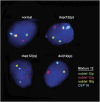Advanced age increases chromosome structural abnormalities in human spermatozoa
- PMID: 21045871
- PMCID: PMC3025794
- DOI: 10.1038/ejhg.2010.166
Advanced age increases chromosome structural abnormalities in human spermatozoa
Abstract
This study explores the relationship between sperm structural aberrations and age by using a multicolor multichromosome FISH strategy that provides information on the incidence of duplications and deletions on all the autosomes. ToTelvysion kit (Abbott Molecular, Abbott Park, IL, USA) with telomere-specific probes was used. We investigated the sperm of 10 male donors aged from 23 to 74 years old. The donors were divided into two groups according to age, a cohort of five individuals younger than 40 and a cohort of five individuals older than 60 years. The goal of this study was to determine (1) the relationship between donor age and frequency and type of chromosome structural abnormalities and (2) chromosomes more frequently involved in sperm structural aberrations. We found that the older patients had a higher rate of structural abnormalities (6.6%) compared with the younger cohort (4.9%). Although both duplications and deletions were seen more frequently in older men, our findings demonstrate the presence of an excess of duplications versus deletions in both groups at a ratio of 2 to 1. We demonstrate that the distribution of duplications and deletions was not linear along the chromosomes, although a trend toward a higher rate of abnormalities in larger chromosomes was observed. This work is the first study addressing the frequencies of sperm chromosome structural aberrations of all autosomes in a single assay thus making a contribution to the clarification of the amount and origin of damage present in human spermatozoa and in relation to age.
Figures



Similar articles
-
Donor age and the frequency of disomy for chromosomes 1, 13, 21 and structural abnormalities in human spermatozoa using multicolour fluorescence in-situ hybridization.Hum Reprod. 1998 Sep;13(9):2489-94. doi: 10.1093/humrep/13.9.2489. Hum Reprod. 1998. PMID: 9806273
-
Frequency and distribution of chromosome abnormalities in human spermatozoa.Cytogenet Genome Res. 2005;111(3-4):199-205. doi: 10.1159/000086890. Cytogenet Genome Res. 2005. PMID: 16192695
-
Frequency of human sperm carrying structural aberrations of chromosome 1 increases with advancing age.Fertil Steril. 2007 May;87(5):1077-86. doi: 10.1016/j.fertnstert.2006.08.112. Epub 2007 Apr 11. Fertil Steril. 2007. PMID: 17433321
-
Analysis of structural and numerical chromosome abnormalities in sperm of normal men and carriers of constitutional chromosome aberrations. A review.Hum Genet. 1997 Jul;100(1):1-21. doi: 10.1007/s004390050459. Hum Genet. 1997. PMID: 9225963 Review.
-
Is there a relationship between sperm chromosome abnormalities and sperm morphology?Reprod Biol Endocrinol. 2006 Jan 25;4:1. doi: 10.1186/1477-7827-4-1. Reprod Biol Endocrinol. 2006. PMID: 16436209 Free PMC article. Review.
Cited by
-
Dramatic fertility decline in aging C. elegans males is associated with mating execution deficits rather than diminished sperm quality.Exp Gerontol. 2013 Nov;48(11):1156-66. doi: 10.1016/j.exger.2013.07.014. Epub 2013 Aug 2. Exp Gerontol. 2013. PMID: 23916839 Free PMC article.
-
De novo deletions and duplications detected by array CGH: a study of parental origin in relation to mechanisms of formation and size of imbalance.Eur J Hum Genet. 2012 Feb;20(2):155-60. doi: 10.1038/ejhg.2011.182. Epub 2011 Sep 28. Eur J Hum Genet. 2012. PMID: 21952720 Free PMC article.
-
A Case of Severe Teratozoospermia and Infertility Due to Homozygous Mutation c.144delC in the AURKC Gene.Cureus. 2023 Aug 12;15(8):e43376. doi: 10.7759/cureus.43376. eCollection 2023 Aug. Cureus. 2023. PMID: 37700958 Free PMC article.
-
Predicting chromosome damage in astronauts participating in international space station missions.Sci Rep. 2021 Mar 5;11(1):5293. doi: 10.1038/s41598-021-84242-5. Sci Rep. 2021. PMID: 33674665 Free PMC article.
-
Impact of Advanced Paternal Age on Fertility and Risks of Genetic Disorders in Offspring.Genes (Basel). 2023 Feb 14;14(2):486. doi: 10.3390/genes14020486. Genes (Basel). 2023. PMID: 36833413 Free PMC article. Review.
References
-
- Jacobs PA. The chromosome complement of human gametes. Oxf Rev Reprod Biol. 1992;14:47–72. - PubMed
-
- Hassold TJ. Nondisjunction in the human male. Curr Top Dev Biol. 1998;37:383–406. - PubMed
-
- Olson SD, Magenis RE.Preferential paternal origin of de novo structural rearrangementsIn: Daniel A (ed): The Cytogenetics of Mammalian Autosomal Rearrangements New York: Alan R Liss; 1988583–599.
-
- Thomas NS, Durkie M, Van Zyl B, et al. Parental and chromosomal origin of unbalanced de novo structural chromosome abnormalities in man. Hum Genet. 2006;119:444–450. - PubMed
-
- Cody JD, Perce JF, Brkanac Z, et al. Preferential loss of the paternal alleles in the 18q- syndrome. Am J Hum Genet. 1997;69:280–286. - PubMed
Publication types
MeSH terms
LinkOut - more resources
Full Text Sources
Medical

